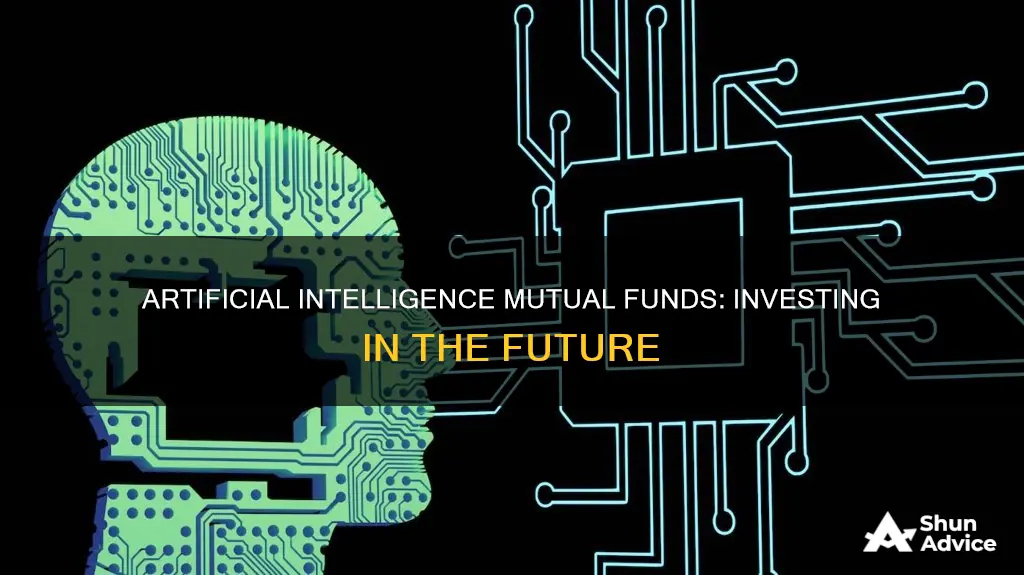
Artificial intelligence (AI) is one of the biggest trends of the 2020s, with the potential to contribute trillions to the global economy in the coming years. AI exchange-traded funds (ETFs) are a great way to invest in this technology, offering reduced transaction costs and a diversified portfolio.
AI ETFs are publicly traded baskets of AI stocks, which are shares of publicly traded companies involved with AI development. Some AI companies develop AI software and large language models, while others produce hardware important to industrial AI, such as graphics processing units.
When choosing an AI ETF, investors should consider their goals and risk tolerance. While investing in AI ETFs can be a great way to bet on the future of AI, it's important to remember that this is a relatively new sector, and these funds may carry more market risk than more diversified investments.
What You'll Learn

Focused AI ETFs
Global X Artificial Intelligence & Technology ETF (AIQ)
Global X Artificial Intelligence & Technology ETF is a five-year-old fund that invests in companies developing AI products and services, as well as those responsible for hardware that facilitates AI for big data uses. The fund has around 80 stocks, including consumer-focused AI companies like Meta Platforms and Netflix, back-end services AI companies like Salesforce, and hardware manufacturers like semiconductor stocks Nvidia and Broadcom. The fund has a US-centric focus, with over 70% of the fund based in the US, but it also holds stocks from 10 other countries, including China, Ireland, and South Korea. The fund has expenses of 0.68%, or $68 annually for every $10,000 invested.
ROBO Global Artificial Intelligence ETF (THNQ)
ROBO Global Artificial Intelligence ETF is a relatively young fund, having launched in May 2020. The fund focuses on companies bringing AI to the masses and those whose products make AI possible. The portfolio of around 60 stocks is divided into two main buckets: Infrastructure (60%), including big data and cloud providers, and semiconductor manufacturers; and Applications & Services (38%), including e-commerce, consulting services, and factory automation. The fund has a strong US focus, with 80% of assets, but also includes stocks from Taiwan, China, Israel, and other countries.
Invesco AI and Next Gen Software ETF (IGPT)
Invesco AI and Next Gen Software ETF tracks the STOXX World AC NexGen Software Development Index, which holds large-cap tech companies like Alphabet, Nvidia, and Meta. The fund targets 100 companies that generate revenue from software and AI, such as data storage, robotics, autonomous vehicles, semiconductors, and web platforms. It has an expense ratio of 0.6%.
Global X Robotics & Artificial Intelligence ETF (BOTZ)
Global X Robotics & Artificial Intelligence ETF has a strong focus on robotics and industrial automation, with clear AI connections to companies like Nvidia and iRobot. The portfolio includes under 50 holdings, with a geographical focus on the US (55%), Japan (26%), and Switzerland (10%). The fund has an expense ratio of 0.68%.
Roundhill Generative AI & Technology ETF (CHAT)
Roundhill Generative AI & Technology ETF targets hardware and software companies developing or supporting generative AI. This actively managed ETF has 51 holdings, with Nvidia, Microsoft, Alphabet, Meta, and Adobe in the top spots. It has an expense ratio of 0.75%.
Activewear: Which Investment Funds are Taking an Interest?
You may want to see also

Limited Exposure AI ETFs
Some of the leading companies that use AI technology include Amazon (AMZN), Tesla Motors (TSLA), Apple (AAPL), and Alphabet (GOOG, GOOGL). These companies are at the forefront of AI innovation and are likely to benefit from the increased adoption of AI in various industries.
- Global X Robotics & Artificial Intelligence Thematic ETF (BOTZ): This ETF has over $1.4 billion in assets under management. It seeks to invest in companies that are expected to benefit from the increased adoption of robotics and AI, including those in industrial robotics, automation, non-industrial robots, and autonomous vehicles. The expense ratio for this fund is 0.68%.
- ROBO Global Robotics & Automation Index ETF (ROBO): ROBO was the first robotics and automation ETF in the market. It holds over 80 stocks across small-, mid-, and large-cap companies worldwide. The fund has $1.19 billion in assets under management, and its expense ratio is 0.95%.
- IShares Future AI & Tech ETF (ARTY): This ETF provides targeted exposure to companies at the forefront of AI innovation in areas such as generative AI, AI data and infrastructure, AI software, and AI services. It aims to capture long-term growth opportunities in the digital disruption and AI space. The expense ratio for this fund is 0.47%.
- ARK Autonomous Technology & Robotics ETF (ARKQ): This ETF focuses on companies involved in autonomous transportation, robotics, 3D printing, energy infrastructure, and manufacturing. While the expense ratio is not mentioned, it is one of the top-performing AI ETFs.
Class C Mutual Funds: When to Invest and Why
You may want to see also

AI-Managed Funds
- Global X Robotics & Artificial Intelligence ETF (BOTZ): This fund was established in 2016 and invests in companies that benefit from AI and automation. It holds 44 stocks, with Nvidia, ABB, Intuitive Surgical, Keyence, and SMC Corp. as its top five holdings.
- ROBO Global Robotics and Automation Index ETF (ROBO): This ETF focuses on companies driving transformative innovations in robotics, automation, and AI. It holds 77 stocks, including Intuitive Surgical, Novanta, Zebra Technologies, Fanuc, and ServiceNow.
- IShares Robotics and Artificial Intelligence ETF (ARTY): The iShares Robotics and Artificial Intelligence ETF aims to track the performance of companies that could benefit from long-term opportunities in robotics and AI. It has over 100 stock holdings and includes companies like Lumen Technologies, SiriusXM Holdings, Genius Sports, Hello Group, and Pegasystems.
- First Trust Nasdaq AI and Robotics ETF (ROBT): This ETF tracks the Nasdaq CTA Artificial and Robotics index and holds 107 stocks, including SentinelOne, Appian, and Palantir.
- DWS Science and Technology Fund - Class A (KTCAX): This mutual fund aims for capital growth by investing in common stocks of science and technology companies. Its top AI stock holdings include Microsoft, Nvidia, and Twilio.
- Fidelity Select Technology Portfolio (FSPTX): This non-diversified fund aims for capital appreciation by investing in securities of companies that offer or benefit from technological advances. Its top AI stock holdings include Amazon, Facebook, and Microsoft.
- Franklin DynaTech Fund Class A (FKDNX): The Franklin DynaTech Fund invests in common stocks of companies that its manager believes are leaders in innovation and take advantage of new technologies. Its top AI stock holdings include Amazon, Microsoft, and Google.
When considering which AI-managed fund to invest in, it is important to look at the fund's holdings, expense ratio, dividend yield, and past performance. Diversification is also key, as you want to ensure your investment is spread across a range of companies and sectors.
Investing in Funds: Smart Money Management for Long-Term Growth
You may want to see also

AI-Enhanced or AI-Powered ETFs
AI-Enhanced or AI-Powered Exchange-Traded Funds (ETFs) are funds that use artificial intelligence to select individual securities for inclusion in the fund. These ETFs are designed to benefit from the increased adoption and utilisation of artificial intelligence, including in robotics, automation, natural language processing, and autonomous vehicles.
One example of an AI-powered ETF is the AI Powered Equity ETF (AIEQ), which utilises IBM Watson to analyse millions of data points across news, social media, industry and analyst reports, financial statements, and more. This ETF is the first actively managed fund to fully utilise artificial intelligence for stock selection. It aims to provide long-term capital appreciation and targets a maximum risk-adjusted return versus the broader U.S. equity market.
Another example is the Qraft AI-Enhanced U.S. Large Cap ETF, which uses a proprietary AI engine developed by LG AI Research and Qraft Technologies. This ETF seeks long-term capital appreciation by dynamically shifting between five proven factors: quality, size, value, momentum, and low volatility. The fund combines human intuition and oversight with the processing and analytical capabilities of AI.
The Global X Robotics & Artificial Intelligence ETF (BOTZ) is another option. Established in 2016, this fund invests in companies that benefit from AI and automation, including those in industrial robotics, automation, non-industrial robots, and autonomous vehicles. Its top five holdings include Nvidia, ABB, Intuitive Surgical, Keyence, and SMC Corp.
Mutual Funds: Diversify Your Investments, Secure Your Future
You may want to see also

Tech ETFs
Global X Artificial Intelligence & Technology ETF (AIQ)
AIQ offers broad exposure to the AI value chain, similar to the Nasdaq-100 but with a stronger focus on technology and mid-cap growth companies. It has an expense ratio of 0.68% and holds stocks such as Nvidia, Qualcomm, Netflix, Meta, Alphabet, and Amazon. AIQ is one of the most popular AI-themed ETFs with over $1.8 billion in assets under management.
ROBO Global Robotics and Automation Index ETF (ROBO)
ROBO focuses on companies driving transformative innovations in robotics, automation, and AI. It has an expense ratio of 0.95% and holds stocks such as Intuitive Surgical, Novanta, Zebra Technologies, Fanuc, and ServiceNow. ROBO has underperformed the S&P 500 since its inception in 2013.
IShares Robotics and Artificial Intelligence ETF (IRBO)
IRBO aims to track the results of an index of developed and emerging market companies that could benefit from long-term opportunities in robotics and AI. It has an expense ratio of 0.47% and holds stocks such as Nvidia, Lumen Technologies, SiriusXM Holdings, Genius Sports, and Hello Group. IRBO has underperformed the S&P 500 since its founding in 2018.
First Trust Nasdaq Artificial Intelligence and Robotics ETF (ROBT)
ROBT tracks the Nasdaq CTA Artificial and Robotics index, which includes companies engaged in AI and robotics across various sectors. It has an expense ratio of 0.65% and a dividend yield of 0.27%. ROBT holds stocks such as SentinelOne, Appian, Palantir, ServiceNow, and Pegasystems.
Global X Robotics & Artificial Intelligence ETF (BOTZ)
BOTZ invests in companies that benefit from AI and automation, including those in industrial robotics, automation, non-industrial robots, and autonomous vehicles. It has an expense ratio of 0.68% and holds stocks such as Nvidia, ABB, Intuitive Surgical, Keyence, and SMC Corp. BOTZ has underperformed the S&P 500 since its launch in 2016.
Invesco AI and Next Gen Software ETF (IGPT)
IGPT offers exposure to large-cap tech companies in the AI space, such as Alphabet, Nvidia, and Meta. It tracks the STOXX World AC NexGen Software Development Index and has an expense ratio of 0.6%.
Roundhill Generative AI & Technology ETF (CHAT)
CHAT targets hardware and software companies developing or supporting generative AI development. It is an actively managed ETF with an expense ratio of 0.75%. CHAT holds stocks such as Nvidia, Microsoft, Alphabet, Meta, and Adobe.
These Tech ETFs provide a diverse range of options for investors looking to gain exposure to the growing field of artificial intelligence.
Vanguard Mutual Funds: Are They Worth the Investment?
You may want to see also
Frequently asked questions
AI mutual funds are publicly traded baskets of AI stocks, which are shares of publicly traded companies involved with AI development.
Some examples of AI mutual funds include the Global X Robotics & Artificial Intelligence ETF, the ROBO Global Robotics & Automation Index ETF, and the iShares Robotics and Artificial Intelligence ETF.
You'll need an investment account, such as a brokerage account or an individual retirement account (IRA), to invest in AI mutual funds.
AI mutual funds offer diversified exposure to the expanding AI market and reduce overall market risk by spreading bets across multiple stocks.
AI mutual funds are relatively new and carry more market risk than more diversified investments. The performance of AI stocks can be influenced by news-related fluctuations and regulatory changes.







